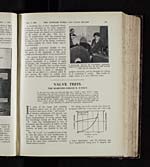John Logie Baird (1888-1946)
Account of some experiments in television
MAY 7, 1924
THE WIRELESS WORLD AND RADIO REVIEW
155
A revovling disc is here employed where
lamps are arranged in the same staggered
formation as on the disc of the transmitter,
and these lamps are joined to a cummutator
at the centre of the disc. This disc is
run in syncrhonism with the trasmitting
disc, and the image is reproduced by the
flashing in and out of the lamps, continuity
of vision making the whole image appear
simultaneously
A machine somewhat similar to that
described was shown to representatives of
the press at the beginning of this year,
outlines of moving objects being trasmitted.
The system described above, in common
with other systems advocated at present,
cosists essentially of a method of rapid
telegraphy, the transmitter being actuated
by light. It is possible that at some future
date means may be discovered of sending
out energy from a point A, bringing it
to bear on an object at a distant point B,
and causing the object to radiate from
its surface energy which, penetrating itner-
[NLS note: a graphic appears here – see image of page]
A photograph showing the transmitting apparatus,
comprising the perforated disc, the disc with serrated
edge and the selenium cell.
mediate obstacles, can be brought to a focus
at A, rendering it visible. This would be
radio vision in a very different sense.
____________________________________
VALVE TESTS.
THE MARCONI-OSRAM R. 5-VOLT.
In the previous issue we reviewed the new "DEV" and the "DEQ" types.
Continuing with our tests, we deal this week with the "R. 5-V.," a valve
which is very popular among those who do not favour dull emitters owing to
battery charging difficulties. It is hoped in the near future to describe, for
the benefit of our readers, tests carried out on all of the standard types of
valves which are on the market. A perusal of these tests will guide the
reader in the selection of valves for particular requirements.
IN spite of the many dull emitting
filament valves now on the market, it
is a fact that many of the "old brigade"
of wireless enthusiasts still operate one
or other of the well-known "R" types.
Many experimenters of to-day gained their
first knowledge during the War, when the
"R" valve was manufactured in tens of
thousands and the number of valves of this
type still being sold proves that some
workers, at least, are faithful to the old
love.
The "R. 5-volt" is a modified form of the
R, and the object of such modification is,
we are told, with the double object of
retaining the characteristics of the latter,
but at the same time embodying construc-
tional improvements.
The whole electrode system has been re-
designed, with the result that the valve has
[NLS note: a graphic appears here – see image of page]
a lower impedance, and the filament has
been lengthened, being now V shaped, the


